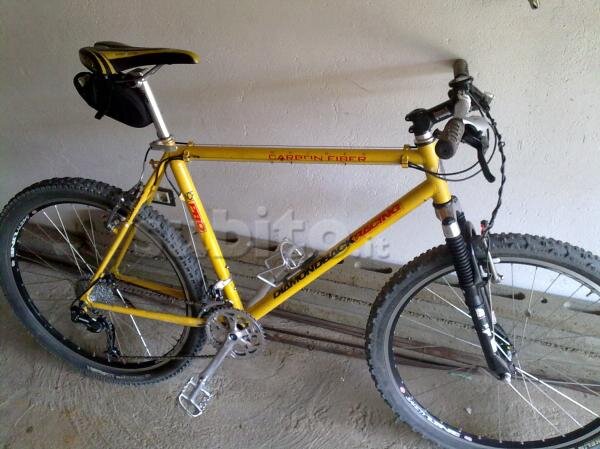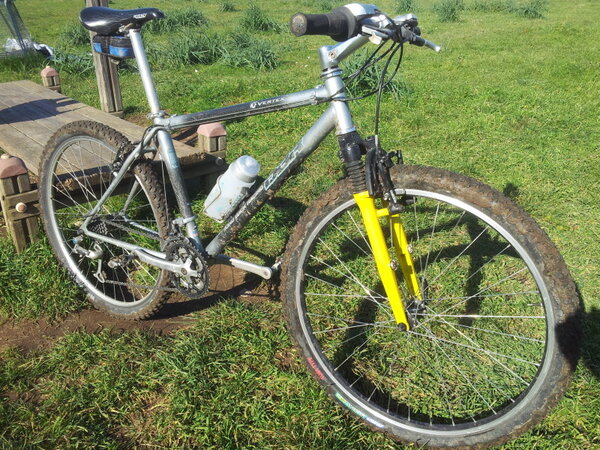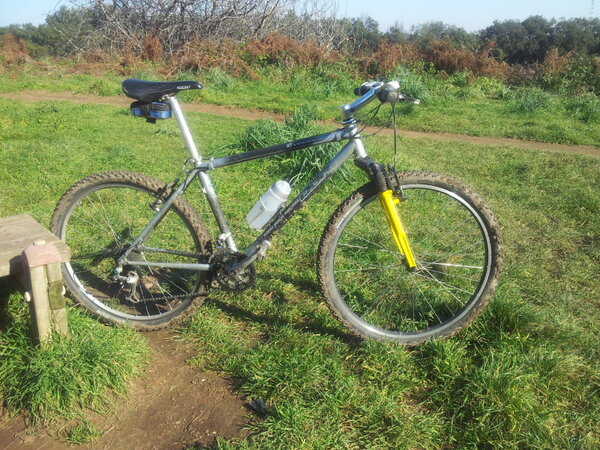just found this nice review on the Vertex, and I have to say from experience, I feel pretty similar with my 96 version
Diamond Back WCF VERTEX CARBON FIBER AS IT SHOULD BE
The irony of carbon fiber as a frame material is that its strength can be its downfall. One misplaced or mislaid layer of the phenomenally stiff stuff can make a bike handle like a brick. We know - we've tested a few. Conversely, with a deft hand, a designer can create something that handles like - well, like the Diamond Back WCF.
The WCF is carbon fiber as it should be - light, resilient, shock- absorbing, and with a slight spring at the bottom bracket that enlivens every ride.
The WCF acronym stands for - get this - Welded Carbon Fiber. If you' re like us, you're probably wondering how one applies a torch to carbon fiber without the result looking like the melted witch at the end of The Wizard of Oz. The secret is that Diamond Back's own carbon tubes are bonded to chrome-moly steel inserts, which are then TIC- welded together. (The rear triangle is chrome-moly.) This avoids the sometimes heavy and expensive carbon-fiber tube junctions. Clever, huh? But not easy. According to designer Brent Graves, numerous prototypes were produced and tested before arriving at the correct sleeve length and tube overlap. The challenge was to ensure a thorough, sound weld, yet keep the bonded area from suffering heat damage.
Bicycling completed its rigorous test, including the rock-strewn Cactus Cup race, without fatigue damage (to the bike, anyway). But we'll be interested in seeing how the WCF's unique construction process holds up over time. It results in a of just under 4 pounds, and an excellent complete bike weight of 23.86. No need to put this one on a diet to go racing. Affix the number plate and proceed to the head of the field.
Diamond Back correctly set out to create a frame that was resilient and would shed vibration - the best attributes a plastic bike can have. They succeeded. The WCF frame acted like a high-frequency filter on rock-strewn riders. Arizona singletrack, muting the worst of the noise and allowing you to finish less fatigued than you would on a steel bike. The bike was also a pleasure to ride out of saddle, with a springiness that invites one to sprint out of every apex. Fun. We also approved of the riding position of our 18-inch test bike, with its long, low 22.5-inch top tube and 14-cm stem - just right for this 6-foot rider.
We could hardly fault the component spec either (aside from the inexplicable chain breakage experienced in the race). The Shimano XT/LX drivetrain with Grip Shift SRT 800 X-Ray shifters provided sure shifts. In fact, Arizona's undulating single-track is exactly where the Grip excels, allowing you to maintain a precise cadence with constant, quick cog shifts, even out of saddle. The Avenir Dial-Adjust seatpost offered the easiest fore/aft and seat angle adjustments this tester has ever experienced. We also liked the light, comfortable Ritchey Vector Prolite saddle, and the solid wheel spec (Mavic 230 SBP rims and 32 butted stainless spokes). The supple Tioga Psycho-K 26x1.95-inch tires offered good traction, but desert riding devoured a pair in just a week (due to wear and a sidewall cut).
Complaints? We found the front end somewhat vague during attempts to wrestle it through technical, boulder-strewn single-track due to independent leg movement in the Manitou Comp elastomer suspension fork. An aftermarket fork bridge might help. And while the budget- level fork supplied more than ample compliance (we couldn't have done the race without it), we found it grossly underdamped. We wouldn't have said this a year ago, but I'm afraid we've been forever spoiled by the addition of oil damping to elastomer models such as the Rock Shox Judy and Manitou's own EFC model. Let's hope the feature continues to come down-market. And finally, we noticed the lack of bar-ends, but consider it a reasonable cost-cutting measure that's easily remedied with a trip to the local fat tire trading post. Ditto for the feet belts. Leave some room in the budget for your favorite brand of clipless pedals.
Was the WCF made for the desert? We have to believe so, since our Diamond Back came face-to-face with its real-life counterpoint, coiled and ready to strike [ILLUSTRATION OMITTED], on one pre-race ride. It was about the only obstacle we hesitated to negotiate on this confidence- inspiring rig.
In short, the WCF offers the best of what has made this tester committed to carbon in his personal bike stable. If you're pondering the purchase of a plastic bike, run, don't walk, to your Diamond Back dealer.
Author not available, Carbon mountain bikes.. Vol. 36, Bicycling, 07-01-1995, pp 69(9)
http://www.alicehui.com/bicycling/Buying & Reviews/Carbon mountain bikes.htm
Diamond Back WCF VERTEX CARBON FIBER AS IT SHOULD BE
The irony of carbon fiber as a frame material is that its strength can be its downfall. One misplaced or mislaid layer of the phenomenally stiff stuff can make a bike handle like a brick. We know - we've tested a few. Conversely, with a deft hand, a designer can create something that handles like - well, like the Diamond Back WCF.
The WCF is carbon fiber as it should be - light, resilient, shock- absorbing, and with a slight spring at the bottom bracket that enlivens every ride.
The WCF acronym stands for - get this - Welded Carbon Fiber. If you' re like us, you're probably wondering how one applies a torch to carbon fiber without the result looking like the melted witch at the end of The Wizard of Oz. The secret is that Diamond Back's own carbon tubes are bonded to chrome-moly steel inserts, which are then TIC- welded together. (The rear triangle is chrome-moly.) This avoids the sometimes heavy and expensive carbon-fiber tube junctions. Clever, huh? But not easy. According to designer Brent Graves, numerous prototypes were produced and tested before arriving at the correct sleeve length and tube overlap. The challenge was to ensure a thorough, sound weld, yet keep the bonded area from suffering heat damage.
Bicycling completed its rigorous test, including the rock-strewn Cactus Cup race, without fatigue damage (to the bike, anyway). But we'll be interested in seeing how the WCF's unique construction process holds up over time. It results in a of just under 4 pounds, and an excellent complete bike weight of 23.86. No need to put this one on a diet to go racing. Affix the number plate and proceed to the head of the field.
Diamond Back correctly set out to create a frame that was resilient and would shed vibration - the best attributes a plastic bike can have. They succeeded. The WCF frame acted like a high-frequency filter on rock-strewn riders. Arizona singletrack, muting the worst of the noise and allowing you to finish less fatigued than you would on a steel bike. The bike was also a pleasure to ride out of saddle, with a springiness that invites one to sprint out of every apex. Fun. We also approved of the riding position of our 18-inch test bike, with its long, low 22.5-inch top tube and 14-cm stem - just right for this 6-foot rider.
We could hardly fault the component spec either (aside from the inexplicable chain breakage experienced in the race). The Shimano XT/LX drivetrain with Grip Shift SRT 800 X-Ray shifters provided sure shifts. In fact, Arizona's undulating single-track is exactly where the Grip excels, allowing you to maintain a precise cadence with constant, quick cog shifts, even out of saddle. The Avenir Dial-Adjust seatpost offered the easiest fore/aft and seat angle adjustments this tester has ever experienced. We also liked the light, comfortable Ritchey Vector Prolite saddle, and the solid wheel spec (Mavic 230 SBP rims and 32 butted stainless spokes). The supple Tioga Psycho-K 26x1.95-inch tires offered good traction, but desert riding devoured a pair in just a week (due to wear and a sidewall cut).
Complaints? We found the front end somewhat vague during attempts to wrestle it through technical, boulder-strewn single-track due to independent leg movement in the Manitou Comp elastomer suspension fork. An aftermarket fork bridge might help. And while the budget- level fork supplied more than ample compliance (we couldn't have done the race without it), we found it grossly underdamped. We wouldn't have said this a year ago, but I'm afraid we've been forever spoiled by the addition of oil damping to elastomer models such as the Rock Shox Judy and Manitou's own EFC model. Let's hope the feature continues to come down-market. And finally, we noticed the lack of bar-ends, but consider it a reasonable cost-cutting measure that's easily remedied with a trip to the local fat tire trading post. Ditto for the feet belts. Leave some room in the budget for your favorite brand of clipless pedals.
Was the WCF made for the desert? We have to believe so, since our Diamond Back came face-to-face with its real-life counterpoint, coiled and ready to strike [ILLUSTRATION OMITTED], on one pre-race ride. It was about the only obstacle we hesitated to negotiate on this confidence- inspiring rig.
In short, the WCF offers the best of what has made this tester committed to carbon in his personal bike stable. If you're pondering the purchase of a plastic bike, run, don't walk, to your Diamond Back dealer.
Author not available, Carbon mountain bikes.. Vol. 36, Bicycling, 07-01-1995, pp 69(9)
http://www.alicehui.com/bicycling/Buying & Reviews/Carbon mountain bikes.htm


